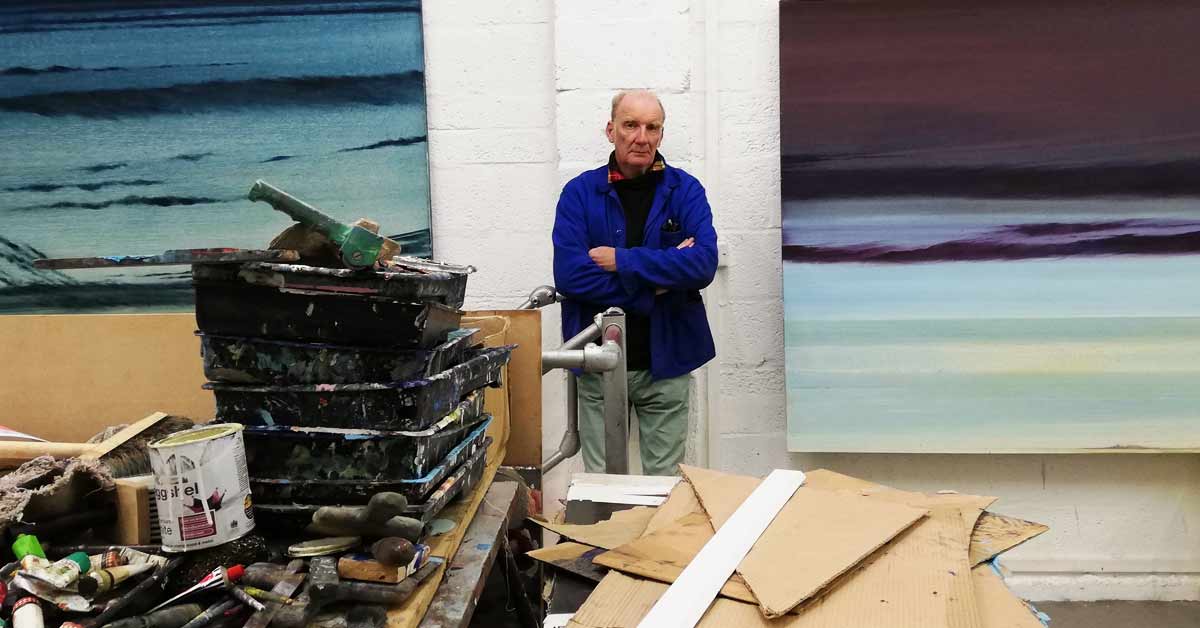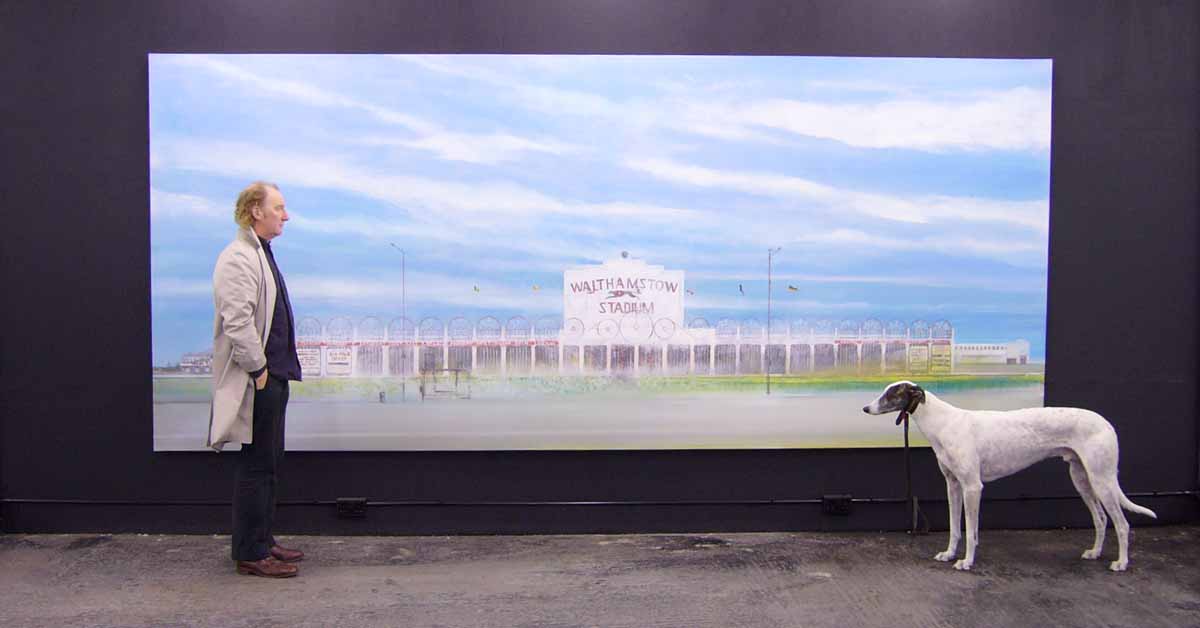“Follow the paint” on a unique tour of artist Jock McFadyen’s studio whilst he reveals the mastery behind his paintings and artistic legacy

Forsters’ Head of Art and Cultural Property, Catherine Hill, joins longstanding client Jock McFadyen at his artist studio in London Fields for a captivating conversation in which Jock reveals his painting techniques, reflects on a 50-year career and the challenges of accepting the kind of artist you’ve become, as well as musings on the future of the art market. Jock wraps up the discussion by sharing some surprising advice to young artists, originally revealed by another well-known Royal Academician.
This article provides extracts of the most fascinating parts of the interview but do watch the videos for the richest insights and a unique glimpse of Jock’s working studio.
Part 1: Jock on the myth of painting landscapes and the skill of depicting skies
As Jock shows Catherine around his studio, they pause to view some of his paintings on display. Jock discusses how he is going back to some of his old paintings to rework them. He reveals to Catherine how he works up a scene in a painting:
“It’s not really imagination… because the paint throws up its own chances.
So you follow the paint, the paint is moved at the speed of thought, so there’s lots of visual research. In other words, photography, roughing things out, telling lies, saying I’m going to move this building across to here or chop that bit off, or I don’t like that mountain and all landscape painters do this.
The majority of paintings in the world are studio paintings, and the minority of paintings in the world are done from life…
Art is short for artifice, so visual research is important as is imagination. But you follow the paint.”
After some gentle persuasion, Jock shares more about his painting techniques:
“I like to paint in a method that’s called ‘wet on wet’ so you pour paint on and you paint on while the paint is still wet, even detail you can do that with. So paintings are in a constant state of adjustment.
But when you’re doing the skies…it’s a game of chance because the skies are liquid and the real sky is liquid. The real sky out there, out of these windows, because clouds are water floating about and if you’ve got paint floating about on here, you can replicate a sky…
I’m always trying to get light to come from the painting that’s underneath and the fact that the paint of the sky is liquid which solidifies overnight [helps this] because if the paint is thin, it is all oil paint, but it will be dry enough to work back into…
I think you’ve got to have the painting keep its energy, so you’re always fighting against flatness.”
Part 2: Jock on cataloguing a lifetime’s work and curating an artistic legacy
Catherine and Jock move on to the area of the studio where most of Jock’s art work is stored. Canvases of all shapes and sizes are stacked on shelves and scattered around the workspace; some of which will be reworked, and others kept to form part of Jock’s artistic legacy – a challenging endeavour that Catherine and Forsters’ Art Group have been advising him on.
Catherine asks Jock to reflect on the experience of attempting to archive art works that will represent him as an artist in perpetuity:
“It’s something that happens to painters at a certain time. If you are a young artist, say you’re 30… you’re setting out, you’re still deciding what kind of artist you [want] to be. Because the contemporary art business… is a sea of possibilities and options.
And then, this is a terrible expression “mid-career”, an artists of 50 years old, has gone some way, and they’re consolidating and they’re understanding the ramifications of the decisions they’ve made 20 years before.
But when you’re 70, you’re in neither position. You’re in the business of turning around and looking at the footprints in the snow and…not deciding at all. You have to accept what kind of artist you actually are. The decision making is over. This is what you turned out to have become. And it’s too late to change.
It’s not too late to experiment and go in new directions. What I mean is you can’t deny what you’ve previously done over the last 40 or 50 years because it’s there, it’s evidence and that is what you have to accept… Even if you hate it, you have to say, well, I seem to have done this.
…And of course, if you don’t like something, you can destroy it and shape what you want to leave in the world after you pass, so it is something which is really important and it’s something that is up to the artist to do unless you have curators you can really trust.
Because most artists who get to my age have got works in public collections and those will be there in perpetuity and so they define what kind of artist you are. So you have to join in with that perception of yourself, which is the official story of what you’ve done. Even if…sometimes you find your work in the wrong context. You can’t do anything about that. No sort of manipulation of your external image or appropriation of you or someone misconstruing…
But you know, time will pass and then work will be seen in a purer light.”
Part 3: Jock on the changing business of art and the future direction of the art world
Catherine and Jock’s conversation then shifts to the business side of being a successful artist and how this has changed throughout his career. As art becomes arguably more commercialised but with that more accessible to a wider audience of potential collectors, Catherine asks for his views as to when and how the art world had changed:
“There are three stages I think of the art business.
When we were in the student refectory at Chelsea Art School off the Kings Road, crying into our cold tea, thinking about what we’re going to do when we leave art school, everybody’s dream was to have a three-week solo exhibition in Cork Street. Cork Street was the street where all the galleries were, like Savile Row is to suits, and that was what people wanted.
And, in my career, it’s gone from three weeks in Cork Street to, in the 1990s, it was three days at Art Basel Miami.
And in the nineties and the early 2000s, the group exhibition became just as important as the solo exhibition because it gave you context. And then it moved from three days…to three hours on the Thursday evening at Sotheby’s…
But now we have NFTs and a virtual pair of trainers, and we’re in a strange world because the auction rooms are desperate to get in on NFTs because they daren’t miss anything commercially. So I’ve seen a lot of changes.
But the thing is, back in the day you had a critical backdrop. If you did have one of these exhibitions in Cork Street and I had a few in the 1980s, when that was the thing to have, you hoped to be reviewed by the F.T., The Guardian, The Observer, or The Times. And that was what you needed, the critical backdrop and that’s just art journalism.
But the critical backdrop is not now done by writers – it’s done by money. It’s underpinned by money. So the more important art is the most expensive art.”
As Jock mentions NFTs, Catherine picks up on this hot topic and considers the potential positive aspects for artists of these technological advancements:
“There’s opportunities within blockchain for linking artwork. If you imagine a studio where you can scan your work and it becomes part of the blockchain. It may develop such that the artists then have much more control over their work.
The other idea is that you might be able to link in effectively a quasi-royalty within the blockchain that requires a payment back to the artist every time the works change hand. So I think we’re going to see some quite seismic change.”
As the conversation draws to a close Jock reflects on the wide range of matters discussed and muses:
“It’s amazing. I mean, it’s a case in point that we’ve come here to talk about painting. Of course, we’ve ended up talking about the business side. Money.”
And finally Catherine ends with one last question:
If you are thinking back over your career and also considering young artists today, have you got any key words of advice for them, things you might have done differently yourself looking back at your existing legacy?
Be sure to watch the videos to discover Jock’s surprising answer!
You can view Jock’s artwork at his current exhibition “Tourist without a Guidebook” at the Royal Academy of Arts in London, which Forsters is proudly sponsoring.
To find out more about how Forsters’ Art Group advises living artists and others in the art world please contact [email protected] or visit www.forsters.co.uk/art.
Painting a legacy: How Forsters’ Art Group advised pre-eminent artist Jock McFadyen on his estate planning
Jock McFadyen is a pre-eminent contemporary British painter and Royal Academician who is best known for his gritty urban landscapes and use of texture. Jock’s works are held in 40 museum collections, including the Tate, National Gallery, the V&A, the British Museum and the Scottish National Gallery of Modern Art.
Forsters sponsors acclaimed artist and client Jock McFadyen’s exhibition at the Royal Academy
Forsters are honoured to be sponsoring a five-week long exhibition of celebrated contemporary artist and longstanding Forsters Art Group client Jock McFadyen at the Royal Academy of Arts.






